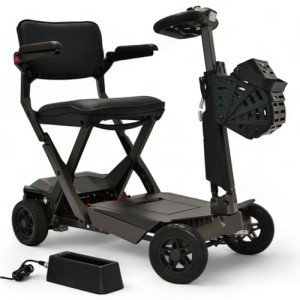A Comprehensive Guide to Buying a Mobility Scooter
Mobility scooters have become a vital tool for lots of people wanting to improve their independence and mobility. With a large range of designs and features offered, choosing the ideal mobility scooter can be intimidating. This short article offers a helpful guide to help customers browse their alternatives, evaluate their needs, and make an informed purchase.
Understanding Mobility Scooters
Mobility scooters are electric lorries created for people who experience mobility difficulties. Read Homepage are especially beneficial for seniors, those with disabilities, or individuals recuperating from injuries. Mobility scooters can vary commonly in regards to style, features, and rates.
Kinds Of Mobility Scooters
Before starting a purchase, it's vital to understand the different types of mobility scooters readily available:
Three-Wheel Scooters:
- Generally more maneuverable in tight spaces
- Lightweight and portable
- Suitable for indoor use
Four-Wheel Scooters:
- Offer greater stability and balance
- Appropriate for outside use over different surfaces
- Typically have a longer battery life
Foldable/Portable Scooters:
- Designed to be quickly transferred and kept
- Can often suit the trunk of a car
- Perfect for those who travel regularly
Durable Scooters:
- Built to accommodate bigger people
- Frequently included more robust functions for outdoor usage
- Typically equipped with bigger batteries for extended variety
Factors to Consider When Buying a Mobility Scooter
1. Weight Capacity
Choose a mobility scooter that can support the user's weight. Many scooters have a weight limit ranging from 250 to 500 pounds. It is essential to make sure that the scooter can accommodate the user conveniently.
2. Variety and Battery Life
The range is how far the mobility scooter can travel on a single charge. Typical ranges differ between 10 to 30 miles. Think about the user's day-to-day activities and select a scooter with an appropriate range.
3. Scooter Dimensions
Consider the size of the scooter, including its weight and dimensions. A more compact scooter might be perfect for narrow hallways and tight spaces, while larger designs provide extra stability and comfort.
4. Terrain Capability
Evaluate where the scooter will mostly be used. If the user prepares to take a trip primarily on pavement, a lightweight design may suffice. However, if the user needs to pass through gravel or irregular surface areas, consider a four-wheel scooter built for off-road usage.
Top Features to Look For
Comfort
- Adjustable Seats: Look for scooters with cushioned and height-adjustable seats to guarantee convenience during travel.
- Armrests: These enhance security and support while navigating.
Security and Visibility
- Headlights and Taillights: Essential for nighttime usage.
- Turn Signals and Reflectors: Improve exposure and security while on the roadway.
User-Friendly Controls
- Joystick or Drive Controls: These ought to be intuitive and simple to manipulate.
- Easy-to-Read Displays: A control panel that shows battery life, speed, and range can boost the user experience.
Extra Features
- Storage Compartments: These provide included convenience for carrying individual products while on the go.
- Weather condition Protection: Consider models with rain covers or windscreens if utilized in variable climate condition.
Cost Considerations
When budgeting for a mobility scooter, prices can range anywhere from ₤ 500 to over ₤ 5,000 depending upon the model, features, and brand. Extra costs may include:
- Extended Warranty: Protects against flaws and can conserve cash in the long run.
- Accessories: Optional features, such as updated seats, lights, or storage options.
| Function | Cost Range |
|---|---|
| Standard Models | ₤ 500 - ₤ 1,500 |
| Mid-Range Models | ₤ 1,500 - ₤ 3,000 |
| High-End Models | ₤ 3,000 - ₤ 5,000 |
Funding Options
Lots of merchants provide funding strategies, and some city government initiatives may supply grants or help for those in requirement. Investigate possible financial help with neighborhood resources or mobility service organizations.
Frequently asked questions about Buying a Mobility Scooter
What is the distinction between a mobility scooter and a wheelchair?
Mobility scooters are motorized and permit users to browse separately, while wheelchairs may need physical help or manual operation.
How do I maintain a mobility scooter?
Regular maintenance involves checking battery life, cleaning up the scooter, and inspecting tires and brakes. Always refer to the user manual for particular standards.
Can mobility scooters be utilized inside your home?
Yes, numerous models are created for both indoor and outside use. Nevertheless, three-wheel scooters tend to be better fit for indoor navigation due to their tighter turning radius.
Are mobility scooters covered by insurance coverage?
Some insurance coverage prepares cover a part of the costs for mobility scooters if they are deemed medically required. Contact your provider for specific details.
How quick can a mobility scooter go?
The majority of mobility scooters have an optimal speed ranging from 4 to 8 miles per hour. However, the suitable pace might vary depending on regional guidelines.
Acquiring a mobility scooter can significantly enhance one's self-reliance and quality of life. By comprehending the types, functions, and costs connected with mobility scooters, potential purchasers can make knowledgeable decisions that suit their requirements and choices. Customization and extensive research are crucial to guaranteeing fulfillment with this important financial investment.

